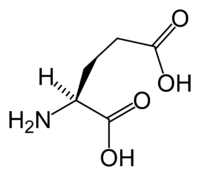
Photo from wikipedia
NMDA receptors are the main Ca2+ permeable excitatory receptors in the mammalian central nervous system. Glutamate along with glycine binding to the extracellular domain of the receptor leads to activation… Click to show full abstract
NMDA receptors are the main Ca2+ permeable excitatory receptors in the mammalian central nervous system. Glutamate along with glycine binding to the extracellular domain of the receptor leads to activation and upon prolonged exposure to ligands desensitization of the receptor. Allosteric modulators such as zinc bind to an extracellular amino terminal domain and lead to inhibition. We have used luminescence resonance energy transfer (LRET) to study the average conformational changes induced by agonists, partial agonists and allosteric modulators in NMDA receptors expressed in HEK-293 cells. These studies provide insight into the conformational changes in the extracellular domain that lead to activation and allosteric inhibition of the receptor in a non-purified cell based system. While the LRET studies along with previous X-ray structures provide insight into the extracellular domains of the receptor, the changes at the transmembrane domain and hence mechanism of how the changes at the extracellular domain gate the channel are still largely unknown. To address this question we have used smFRET to study the changes at the first transmembrane segment between the resting, agonist bound, and inhibitor bound states. These studies provide insight into the conformational dynamics in this transmembrane segment associated with activation, desensitization and allosteric inhibition of the receptor.
Journal Title: Biophysical Journal
Year Published: 2017
Link to full text (if available)
Share on Social Media: Sign Up to like & get
recommendations!